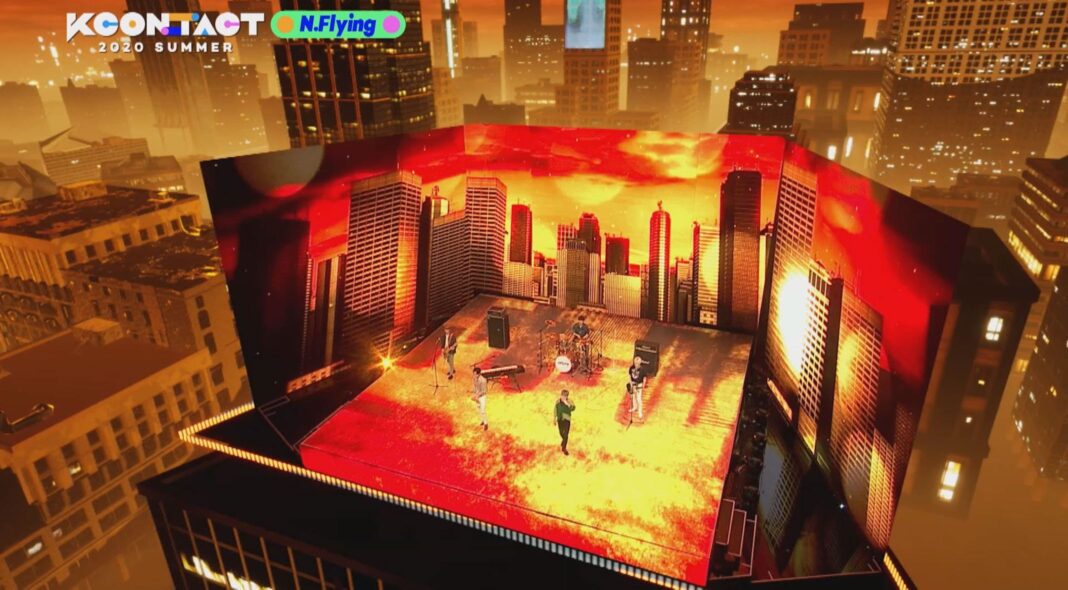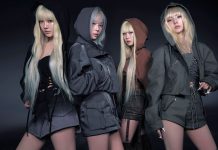Since the coronavirus pandemic began, we’ve all been missing the thrill of live music, be that a big, no-holds-barred stadium extravaganza or being crammed into the sticky surroundings of small venues to discover your new favourite band. The novelty of tuning into a livestream on Instagram or Facebook, direct from an artist’s living room or childhood bedroom, has worn off quickly; a miserable combo reminding us what we’ve been missing out on, imploding the fantasy and iconography of pop stars, and adding to the draining fatigue of a new world of communicating entirely through screens.
As lockdown rules have eased in some parts of the west over the last few months, we’ve seen more ambitious attempts at online concerts. The Weeknd recently took over TikTok with a virtual reality show while the VMAs used XR (a mix of reality and virtual reality production) in performances by the likes of Machine Gun Kelly and DaBaby. This whole time, though, one country has been leading the way in the digital concert space and bridging the gap between standard livestream and mind-blowing arena epic.
Thanks to the South Korean government’s solid and swift response to the first coronavirus outbreak in the republic, Korea never went into full lockdown like the ones we’ve seen across the US and Europe. People could still work, public spaces were largely still open and, with social distancing and other safety measures in place, artists could rehearse for and hold audience-free concerts in studios that were both spacious enough for them to do more than just sit and strum an acoustic guitar and equipped to enable the use of boundary-pushing technology.
Big Hit’s young boyband Tomorrow X Together were one of the first to take things online in March when their planned Dream X Together fan meeting was no longer able to be held as planned. Broadcast on V Live – a live streaming service regularly used by idols to communicate with their fans – the group incorporated some of the platform’s tools into the show, reading and responding to comments from the chat box that appears beside any stream. Where gig-goers would usually cheer for a band to return to the stage for an encore, a title screen asked TXT’s fanbase MOA to click the heart button to get them back for one last song. It was an intriguing first glimpse at the interactive possibilities, which have since become more sophisticated and imaginative as the need to promote solely online has continued.
Tune into any K-pop artist’s online concert now and you’ll likely see one – if not all – of a few things – a wall of fans cheering on from home as if replicating a venue crowd on Zoom, real-time video calls with a few lucky viewers, and each act’s own take on merging online chatrooms with between-song banter. For the groups performing – as well as those watching online from all over the world – being able to see and speak to their fans has helped their sets this year feel at least a little closer to a real gig.
“It’s been a while since we’ve been on stage interacting with our fans so I was delighted and got so much energy from being able to communicate with them using those methods,” says Miyeon, one-sixth of girl group (G)I-DLE, who held their virtual ‘I-LAND: WHO AM I’ concert in July. “It really felt as if we were together in the same place.”
Being able to see silent faces and comment-filled chatrooms doesn’t quite replace the feeling of being in a noisy crowd though. Just as closed-door football matches have found a solution to playing in eerily quiet stadiums, so too K-pop artists have come up with a new way to inject more energy into these virtual shows. During ‘LATATA’ at (G)I-DLE’s show, the group were surprised to hear the sound of their fans’ chants piercing through the mix. When their voices first appeared, the band couldn’t keep broad grins from spreading across their faces.
“I would have never imagined and I was very surprised,” says Soojin. “It gave me so much energy. For youngest member Shuhua, even just being able to hear their fans’ disembodied voices had a big impact. “It relieved my anxiety right away,” she explains. “It was such a touching moment!”
Similarly, when Monsta X held their own ‘From Seoul With Luv’ concert online in August, they used crowd noise recorded at physical shows in 2019, giving ‘Shoot Out’ and ‘Hero’ a new potency in our distanced world. The band were also surprised during their appearance at the virtual KCON:TACT festival in June by a “fan featuring stage” for ‘Stand Up’. The Zoom gallery of fans behind them suddenly became unmute during the song. “The energy that Monbebe [Monsta X’s fans] actually give us is enormous, so there’s a big difference [between performing with and without them present],” says singer Kihyun.
Even with technology creating the illusion of something close to a normal concert experience, it can be hard to make digital performances feel as intimate as being face-to-face with your favourite artist. (G)I-DLE managed to bridge the gap between virtual tricks and IRL warmth during ‘I-LAND: WHO AM I’, their performance of ‘POP/STARS’ marked by an on-screen effect that snapped screenshots in the same way that fans watching at home would capture souvenirs of the concert, while ‘Uh-Oh’ had them give the camera crew a break and film themselves by passing around a singular selfie stick instead.
“We tried to make our fans feel as intimate as possible by using effects and gimmicks that can only be used on an online concert,” Minnie explains, while rapper Soyeon adds they wanted to “make our fans feel as if we were up close”.
Other artists have taken different approaches to achieve that feeling. BTS’ ‘Bang Bang Con: The Live’ show in June (which broke the Guinness World Record for most-viewed livestream concert) saw them gather for chats in a living room area between songs. Monsta X did something similar at their own event, answering questions from fans and sharing their own experiences of quarantine life, while also incorporating VTs of behind-the-scenes footage and interviews.
“Because the situation is not so good, we came to think about how to communicate with our fans and have a good time doing our duty as an artist,” says leader Shownu of the idea behind the innovations, while Hyungwon adds they wanted to do as much as possible to “soothe the fans’ disappointment” of not being able to meet in person.
Where some K-pop virtual shows have felt homey and cosy, others have built worlds of fantasy. (G)I-DLE’s ‘I-LAND: WHO AM I’ set up a new world that only existed for the length of the concert and was inspired by the band’s fandom name, Neverland. “We wanted to bring the concept of imagination and fairies to reality through the [opening] VCR so that our fans can feel like they are actually in the I-LAND,” explains Minnie.
“Because it’s an online concert, we wanted to make our fans feel as if they’ve seen a movie and travelled somewhere, instead of directly sharing the heat of the moment,” notes Soyeon.
The girl group aren’t the only ones to attempt to transport their fans to another place. Twice’s ‘World In A Day’ concert in August saw the nine-member group digitally traversing the world, stopping at 16 cities including Seoul, Bangkok, New York and Mexico City, transferred between each by a VR taxi.
The technology used in many K-pop artists’ shows, such as Twice’s, has pushed boundaries further than a typical physical concert could. BTS might have lightly used AR during their ‘Love Myself: Speak Yourself’ tour in 2019, but operating exclusively online has given acts a chance to go further and flashier than ever. When SuperM kicked off SM Entertainment’s BeyondLIVE series in April, they delivered a show that, at times, made it seem as if rain was falling over and around the stage, that glossy, glowing arches were swooping over Taemin on his solo song ‘Move’ and – most impressively of all – freed the band from a digital cage while tigers prowled and leapt around them.
When annual, multi-location festival KCON went online in June for KCON:TACT, its organisers didn’t settle for simply inviting a host of artists to perform in a studio. Instead, they pulled out all the stops with VR, AR and XR used for performances and backstages interviews, the stage changing to look like a section of ocean suspended in the sky for Ateez’s ‘Wave’ or a fiery, dystopian world for Stray Kids’ ‘God’s Menu’.
“With all of the experience we have putting on KCON live and in-person, we know what it takes to create an event that brings fans as close to their favourite artists as possible,” says Kim Hyun Soo, head of global festivals at entertainment company CJ ENM. “With that in mind, we knew that the use of those and other technologies would be essential to try and recreate that experience through the virtual concert.”
KCON:TACT – livestreamed to 4.81 million viewers on YouTube over the course of a week – didn’t only feature live performances, but an ambitious 24/7 schedule of behind-the-scenes programming like the Real Idol 24hr documentaries with TOO and Loona. “Putting on a show of this scale for the first time with limited resources including staff and equipment was indeed challenging,” says Kim. The KCON team were able to pull it off without a hitch, though, thanks to “non-stop discussion and countless number of testing”.
While the festival progressed seamlessly, there’s no doubting livestream events bring with them their own set of trials. “The biggest challenge and constant dilemma for us when it comes to live event production – not just for KCON:TACT but any show – is always a trade-off between creative innovation and flawless broadcast,” explains Kim. “Trying something new and innovative comes with inevitable instability such as technical glitches and hiccups, but with “safety” – [or] “flawlessness” being one of our top priorities as a show producer, we have to pull off our first try like it’s our 10th, while continuously taking on new challenges.”
For the artists, they also have their own concerns before hitting the virtual stage. Monsta X’s Joohoney narrows these down to “how well you deliver energy to your fans” and being able to “prepare the performance structure and sound” in a way that creates an “atmosphere [that’s] connected to the show”.
Although the pandemic has caused many to have to think up new ways to deliver their performances, the KCON team were already working on ideas for virtual events before COVID struck. Kim says, given the success of the first KCON:TACT (a second is planned for October), he sees a digital component of the festival becoming “an addition to the physical events we do around the world”.
He also envisions a future where the technologies used at online concerts in this time will merge with IRL live show production. “The way the trend is going we think virtual events and technologies like the ones used in KCON:TACT will be used in future live events to enhance the experience,” he says. “This is only the beginning of what’s to come when it comes to live music experiences.”
In the meantime, South Korea is certainly taking this new realm of digital performances seriously – earlier this month it was announced that the Ministry of Economy and Finance were planning to spend ₩29billion (£20million) on creating an online K-pop concert platform to help smaller artists be able to hold their own livestream shows and reach bigger audiences. With fans paying anywhere from £15 to £100-plus for tickets and bonus packages with merch and virtual meet-and-greets, it’s clear that with good innovations – and a big enough fanbase – digital concerts can be just as lucrative as their physical counterparts.
While these virtual shows will never replace the excitement of live music in a real-life venue, K-pop’s stars are trying to stay positive about touring being restricted to online. (G)I-DLE’s Yuqi notes that, while they’d love to be able to meet their fans across the globe, there are some plus points to gathering in one digital space. “It’s amazing that Neverland from afar can also watch it so it would be nice to do more online concerts,” she says. As (G)I-DLE and their peers continue, turn on, tune in and witness the innovations that could inspire artists in the west firsthand.
READ MORE: The best K-pop songs of all time






